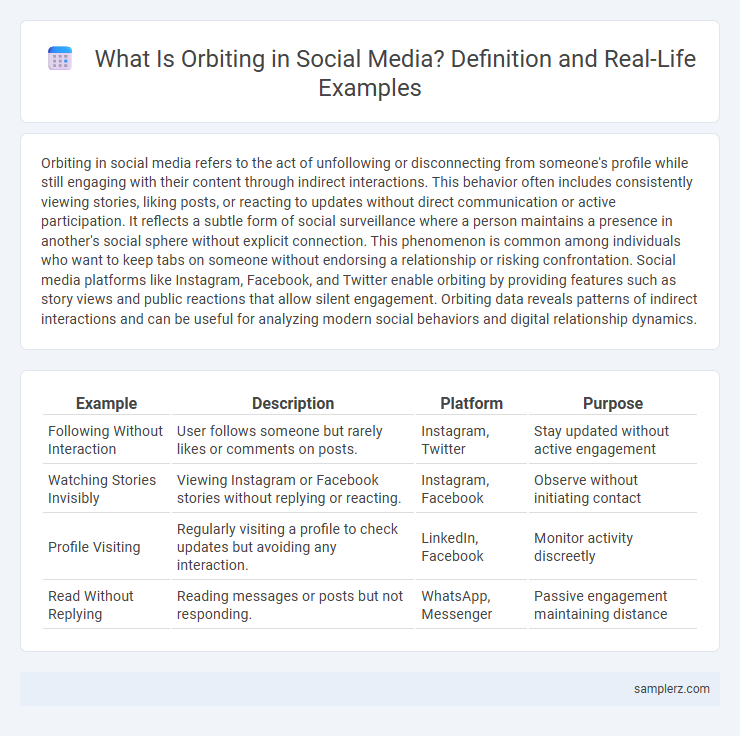Orbiting in social media refers to the act of unfollowing or disconnecting from someone's profile while still engaging with their content through indirect interactions. This behavior often includes consistently viewing stories, liking posts, or reacting to updates without direct communication or active participation. It reflects a subtle form of social surveillance where a person maintains a presence in another's social sphere without explicit connection. This phenomenon is common among individuals who want to keep tabs on someone without endorsing a relationship or risking confrontation. Social media platforms like Instagram, Facebook, and Twitter enable orbiting by providing features such as story views and public reactions that allow silent engagement. Orbiting data reveals patterns of indirect interactions and can be useful for analyzing modern social behaviors and digital relationship dynamics.
Table of Comparison
| Example | Description | Platform | Purpose |
|---|---|---|---|
| Following Without Interaction | User follows someone but rarely likes or comments on posts. | Instagram, Twitter | Stay updated without active engagement |
| Watching Stories Invisibly | Viewing Instagram or Facebook stories without replying or reacting. | Instagram, Facebook | Observe without initiating contact |
| Profile Visiting | Regularly visiting a profile to check updates but avoiding any interaction. | LinkedIn, Facebook | Monitor activity discreetly |
| Read Without Replying | Reading messages or posts but not responding. | WhatsApp, Messenger | Passive engagement maintaining distance |
What is Orbiting in Social Media?
Orbiting in social media refers to the act of someone who has unfollowed or stopped directly engaging with another user but continues to view their stories, like posts, or monitor their activity silently. This behavior allows individuals to stay connected or informed without active interaction, often leading to ambiguous social dynamics. Orbiting is a subtle form of online presence that can affect relationships by maintaining awareness without clear communication.
How Does Orbiting Manifest Online?
Orbiting on social media manifests through subtle actions such as liking or viewing posts without direct communication, maintaining a presence in someone's digital life without engaging in meaningful interaction. This behavior keeps emotional ties ambiguous and can prevent closure after a relationship changes or ends. Common examples include consistent story views or silent follows that signal ongoing interest without initiating contact.
Common Examples of Orbiting on Instagram
Orbiting on Instagram often involves liking or viewing someone's stories without direct interaction, such as commenting or messaging, which keeps the person subtly present in their feed. Typical behaviors include consistently engaging with posts through likes or reactions while avoiding direct communication, maintaining a low-profile connection. This silent engagement signals ongoing interest without explicit contact, reflecting a modern form of social media presence and observation.
Orbiting vs. Ghosting: Key Differences
Orbiting on social media occurs when someone ceases direct communication but continues to engage with your content through likes, views, or passive interactions, maintaining a presence without explicit contact. Ghosting involves abruptly cutting off all communication and online interaction without explanation or engagement, effectively disappearing from the person's digital and social life. The key difference lies in orbiters remaining visible and engaged through indirect social media actions, while ghosters completely vanish from both personal and social platforms.
Signs You’re Being Orbited on Social Media
Subtle signs you're being orbited on social media include consistent views on your Instagram Stories without interaction, repeated likes on older posts, and frequent but minimal comments on public posts. Orbiter behavior often involves watching your online activity without direct engagement such as messaging or tagging. Tracking patterns like these reveals passive interest and potential hidden followers in your social network.
Psychological Reasons Behind Orbiting
Orbiting on social media occurs when someone maintains a subtle online presence by liking or viewing another person's content without direct interaction, driven by psychological needs such as curiosity, fear of missing out (FOMO), or unresolved emotional attachment. This behavior satisfies the orbiting individual's desire for social connection and control while minimizing vulnerability or confrontation. Understanding orbiting reveals the complexities of digital relationships and the impact of online validation on emotional well-being.
The Impact of Orbiting on Mental Health
Orbiting, a social media behavior where individuals maintain indirect contact by watching stories or liking posts without direct interaction, can negatively impact mental health by fostering feelings of anxiety and confusion. This ambiguous connection often leads to overthinking and decreased self-esteem, as users may interpret the inactivity as rejection or lingering attachment. Research indicates that orbiting disrupts closure and emotional recovery, prolonging social stress and impacting overall well-being.
How to Respond to Being Orbited
When you notice someone orbiting your social media, avoid immediate confrontation and instead monitor their interactions for signs of curiosity or passive engagement. Respond by crafting content that encourages genuine dialogue, such as asking open-ended questions in your posts or stories to invite participation. Maintain a balance between transparency and privacy to foster trust, making it easier to convert orbiters into active followers or collaborators.
Orbiting in Online Friendships and Relationships
Orbiting in online friendships and relationships occurs when someone disengages from direct communication but continues to interact subtly by viewing stories, liking posts, or following activities without initiating contact. This behavior can create confusion and emotional ambiguity, as the person maintains a virtual presence without clear intentions or commitment. Understanding orbiting helps identify boundaries in digital interactions and promotes healthier online relationships.
Tips to Prevent Orbiting on Social Platforms
Orbiting on social media occurs when someone unfollows or stops direct interaction but continues to view your stories or engage with your content subtly. To prevent orbiting, adjust your privacy settings to limit story viewers and use close friends lists for selective sharing, ensuring only trusted people see your posts. Regularly review and manage your follower list to maintain a healthy digital environment and reduce passive observation.

example of orbiting in social media Infographic
 samplerz.com
samplerz.com